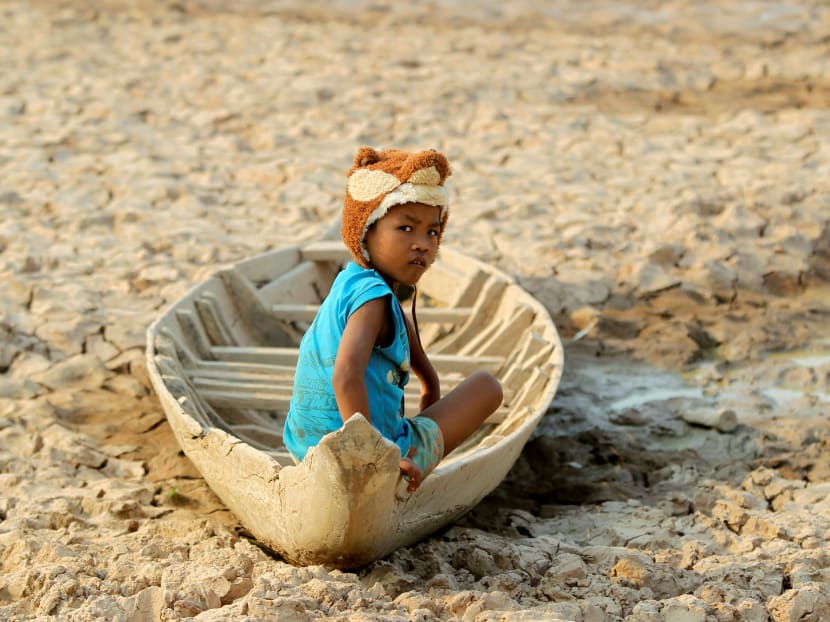South-east Asia to suffer intense, more frequent drought without government action: UN and Asean report
HONG KONG — Drought in South-east Asia may become even more frequent and intense if countries do not take steps to reduce its impact, according to a joint study from the United Nations Economic and Social Commission for Asia and the Pacific (Escap) and Asean.

A girl sits on her boat at a Bak Angrout dried up pond at the drought-hit Kandal province in Cambodia, May 13, 2016.
HONG KONG — Drought in South-east Asia may become even more frequent and intense if countries do not take steps to reduce its impact, according to a joint study from the United Nations Economic and Social Commission for Asia and the Pacific (Escap) and Asean.
“Ready for the Dry Years: Building resilience to drought in South-east Asia”, released on April 19, said the cumulative impact of drought in the region disproportionately affected the poor and heightened inequality, which in turn increased the prospect of violent conflict.
Over the past three decades, droughts have affected more than 66 million people in South-east Asia. One such person is 23-year-old Bonreach Kleng, a volunteer coordinator in Cambodia.
“It’s really hard for us because it’s really hot throughout the year. In some areas of Phnom Penh, there is no water. We live on the third floor so we have to carry water from the ground [floor] to the top,” she said.
“Because of the drought there is no water to produce electricity. The government cannot do anything. They just tell us to buy power banks.”
Read also
The drought-prone area of South-east Asia is concentrated in the north and south of Vietnam, southern Sulawesi and Borneo, and the central part of Java, Sulawesi and Papua.
The study found that ongoing climate change was likely to shift and expand this historical drought area.
One scenario it used was that of a less severe El Nino — a weather phenomenon in which the eastern tropical Pacific Ocean becomes abnormally warm, causing disruptions in the global atmosphere and resulting in extreme weather events such as typhoons, winter storms and droughts from the Pacific Rim to Sub-Saharan Africa.
Should this occur, the drought area in southern Vietnam will extend to Cambodia and southern Thailand by 2050. In Java, the proportion of the island affected by drought will increase from 62 per cent to 72 per cent.
In the same scenario, between the years 2071 and 2100, 96 per cent of the Asean region is likely to be affected by drought. The northern part of Vietnam and Laos will face extreme drought, while there will also be severe drought conditions in eastern Sumatra, northern Borneo and the southern part of Papua.
Still, the report said estimates of the impact of drought on the region were conservative because such events were under-reported and under-monitored.
Countries that depend heavily on agriculture are most vulnerable to the effects of drought, as the sector bears the brunt of around four-fifths of drought-induced economic impact.
Read also
Agriculture generates roughly 11 per cent of value-added GDP for Asean as a whole. It is the primary source of employment in Laos (61 per cent), Vietnam (41 per cent), Indonesia (31 per cent), Cambodia (27 per cent), and the Philippines (26 per cent).
According to the report, drought also worsens social inequality by cutting into the incomes of vulnerable populations.
It found a very strong correlation (88 per cent) between projected conflict risk and natural disasters in the Asean region.
Between 1980 to 2001, more than 80 per cent of localised conflicts in the Asia-Pacific region occurred in areas that were at some stage affected by drought.
To mitigate the widespread and increasing threat of drought to the Asean region, Escap and Asean have proposed three ways governments can prepare for the dry years ahead, within a network of regional cooperation.
These were strengthening drought risk assessment and early warning services; cultivating drought-risk financing markets; and by helping people and businesses adapt better to drought.
Read also
Budget 2019: Total infrastructure bill to rise as S’pore fights climate change and rising sea levels
According to Mr Kleng from Cambodia, the government had thus far not been very helpful.
“They do nothing. They inform us beforehand that we will face this drought and tell us to be careful and make preparations by ourselves,” she said. “They said it’s a natural disaster so they can’t control it.”
Mr Danny Marks, associate professor of environmental studies at City University in Hong Kong, said early warning systems in South-east Asia were weak due to limited technology and funding, while limited communications was another issue.
“Even if the national government knows there’s a drought coming, it has difficulty disseminating this information to rural populations due to the limited capacity of local governments and the fragmentation between national and local government agencies,” he said.
At the regional level, Mr Marks said Asean could help establish social safety nets to help farmers in crises.
“One example would be to create an insurance mechanism that pools together collective risks of agricultural production in the region. It would use wealth-based indices and give farmers insurance when they are struck with major agricultural disasters, including droughts. Countries that are net consumers of agricultural products should help subsidise this scheme.”
At the national level, Mr Marks recommends governments invest in more irrigated land and increase funding devoted to agricultural research that focuses on greener and more affordable technologies, such as seeds which require less water, which can help farmers increase productivity and adapt to drought.
“More dry years are inevitable, but more suffering is not. Timely interventions now can reduce the impacts of drought, protect the poorest communities and foster more harmonious societies,” said UN Undersecretary-General and Executive Secretary of Escap Armida Alisjahbana. SOUTH CHINA MORNING POST






